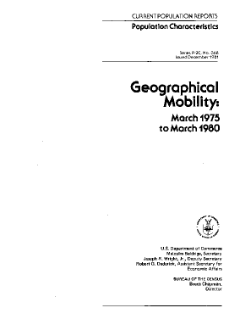
An official website of the United States government
Here’s how you know
Official websites use .gov
A .gov website belongs to an official government organization in the United States.
Secure .gov websites use HTTPS
A lock (
) or https:// means you’ve safely connected to the .gov website. Share sensitive information only on official, secure websites.
-
//
- Census.gov /
- Publications /
- Geographical Mobility: March 1975 to March 1980
Geographical Mobility: March 1975 to March 1980
Geographical Mobility: March 1975 to March 1980
Migration, or geographical mobility, is an important component of demographic change. It has major impact on population distribution as people move between cities and suburbs, metropolitan and nonmetropolitan areas, and regions. It is important to know the characteristics of movers–age, race, sex, occupation, income, education, and marital status–in order to assess the impact that migration may have on the areas of origin and destination.
The mobility data in this report are estimates from the March 1980 Current Population Survey (CPS). They are derived by comparing the locations of each respondent's residence in 1975 with current residence in 1980. In the 1970's, there were several significant changes in the residential mobility patterns of Americans. Some of these changes, especially in regional movements, began in the 1960's for Whites but were not evidenced for Blacks until the 1970's. Changes in the patterns of migration to and from metropolitan and nonmetropolitan areas of the United States were first seen in the 1970's. These trends are discussed in detail in the following sections. The analysis compares the mobility patterns of persons during the late 1960's, using data from the 1970 census, with patterns found in the Current Population Surveys for the early 1970's and in the last 5 years of the decade.
Others in Series
Publication
Publication
Publication
Share
Related Information
Some content on this site is available in several different electronic formats. Some of the files may require a plug-in or additional software to view.
 Yes
Yes
 No
NoComments or suggestions?


Top


